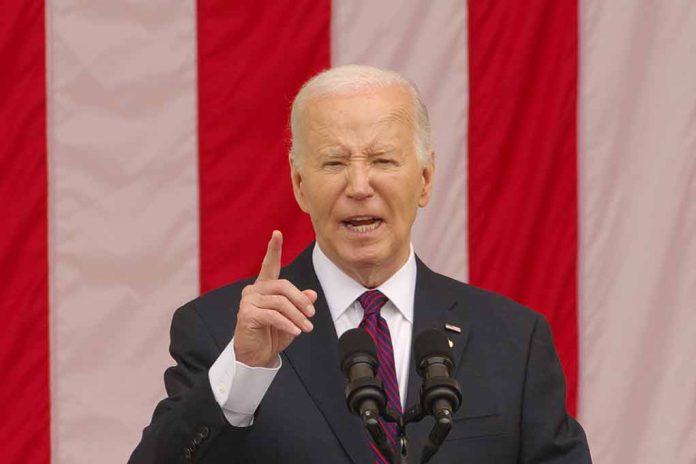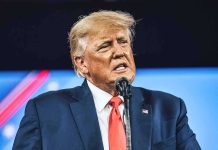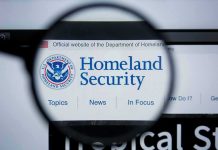
President Biden has authorized a highly classified nuclear strategy to address mounting threats from China, Russia, and North Korea, signaling a significant shift in U.S. defense policy.
At a Glance
- Biden approved a classified “Nuclear Employment Guidance” in March, focusing on China’s expanding nuclear arsenal.
- The plan prepares for potential coordinated threats from China, Russia, and North Korea.
- Pentagon warns of a more complex and dangerous global nuclear landscape.
- Critics fear a new arms race, while supporters argue it’s necessary for national security.
Biden’s Covert Nuclear Strategy Shift
In a move that underscores the growing concerns about global nuclear threats, President Biden has authorized a highly classified nuclear strategy called the “Nuclear Employment Guidance.” This covert operation, approved in March, marks a significant reorientation of America’s deterrent strategy, with a particular focus on China’s rapidly expanding nuclear capabilities.
The strategy, which is updated approximately every four years, addresses the complex challenges posed by multiple nuclear-armed adversaries. It prepares the United States for possible coordinated nuclear challenges from China, Russia, and North Korea, reflecting the Pentagon’s assessment that the global nuclear landscape is becoming increasingly dangerous and unpredictable.
President Biden has reportedly altered the U.S. strategic nuclear plans toward opposing China's burgeoning nuclear arsenal and preparing for possible nuclear coordination between China, Russia and North Korea. https://t.co/rJZhl2Vuj3
— The Washington Times (@WashTimes) August 21, 2024
China’s Nuclear Expansion: A Growing Concern
At the heart of this strategic shift is China’s unprecedented nuclear arsenal expansion. Pentagon officials believe that China’s nuclear stockpiles could rival those of the United States and Russia within the next decade. This rapid growth has prompted a reevaluation of America’s nuclear posture and deterrence strategies.
“The president recently issued updated nuclear-weapons employment guidance to account for multiple nuclear-armed adversaries,” said Vipin Narang, an M.I.T. nuclear strategist who served in the Pentagon. “And in particular,” he added, the weapons guidance accounted for “the significant increase in the size and diversity” of China’s nuclear arsenal.
The urgency of this situation is further highlighted by estimates suggesting that China may increase its nuclear arsenal from 500 to 1,000 warheads by 2030. This dramatic expansion, coupled with Russia’s current stockpile of about 4,000 warheads, presents a formidable challenge to U.S. strategic planners.
Balancing Deterrence and Diplomacy
While the Biden administration is taking steps to strengthen nuclear defenses, it also faces the delicate task of balancing deterrence with diplomacy. The last major nuclear arms control agreement with Russia, New Start, is set to expire in early 2026, with no subsequent agreement in place. This looming deadline adds pressure to an already tense international situation.
“It is our responsibility to see the world as it is, not as we hoped or wished it would be,” Narang emphasized, highlighting the pragmatic approach taken by the administration.
However, critics argue that escalating nuclear defenses could spark a new arms race, potentially destabilizing global security. Supporters of the strategy, on the other hand, contend that these measures are necessary to maintain national security in an increasingly volatile world.
Biden has reportedly approved a new nuclear strategy that refocuses on the 'Chinese threat'
President Joe Biden approved a classified nuclear strategy in March that directed US forces to refocus on potential threats from China, The New York Times revealed on Tuesday, citing… pic.twitter.com/JSsTFh4j2b
— Sputnik (@SputnikInt) August 21, 2024
A New Era of Nuclear Complexity
The current global nuclear landscape is markedly different from the Cold War era. As one expert noted, “It is more complex and less predictable than the old, bipolar contest between America and the Soviet Union. That makes it more dangerous.” This new reality requires a nuanced approach to nuclear deterrence and crisis management.
The Biden administration’s strategy aims to address scenarios where the United States might face multiple nuclear threats simultaneously. These could include Russia attacking a NATO country, China invading Taiwan, and North Korea attacking South Korea. The complexity of these potential crises underscores the need for a robust and flexible nuclear strategy.
As the world grapples with these evolving nuclear threats, the United States finds itself at a critical juncture. The Biden administration’s classified nuclear guidance represents a significant step in adapting to this new reality, balancing the need for strong deterrence with the hope for future arms control agreements. The coming years will likely prove pivotal in shaping the global nuclear landscape for decades to come.
Sources
- Biden Approved Secret Nuclear Strategy Refocusing on Chinese Threat
- Reluctantly, America eyes building more nuclear weapons
- Biden approves nuclear strategy refocusing on China threat – report
- America prepares for a new nuclear-arms race
- No First Use Can Still Help to Reduce US-China Nuclear Risks
- The U.S. Nuclear Arsenal Can Deter Both China and Russia














